Abstract
Neural tube defects (NTDs) and hemivertebra represent major congenital abnormalities of the cranial vault and the fetal spine.
NTDs are the consequence of a failed closure of the cranial and/or the caudal neural tube. Their pathogenesis is unknown; however, an association with folic acid deficiency and a variable incidence of structural abnormalities and karyotype/genetic defects have been reported. NTDs include the spectrum of acrania-exencephaly-anencephaly, encephaloceles, spinal defects (“spina bifida” or myelomeningocele), and combined cranial and spinal defects such as craniorachischisis. Prognosis is strongly dependent on the type of the NTD and the presence or absence of additional structural or genetic findings. Spina bifida, either open or covered by skin, represents a common malformation of the central nervous system. Closed defects generally have a good prognosis, whereas open defects are associated with high rates of mortality and handicap. Acrania-exencephaly-anencephaly sequence and craniorachischisis represent invariably lethal defects. On the other hand, treatment options do exist for encephaloceles and spina bifida. In these latter, prognosis is dependent on the extent of the defect, its location in the skull or in the spine, and the amount of herniated neural tissue. Among NTDs, encephalocele carries the higher chance of associated extracranial abnormalities and chromosomal or genetic defects.
Hemivertebra is among the causes of congenital scoliosis and is caused by the failed development of one half of the vertebral body. Hemivertebra is commonly associated with other skeletal, cardiac, and genitourinary tract anomalies; however, when isolated, it usually carries a good prognosis.
Keywords
congenital anomalies, fetal spine, folic acid, hemivertebra, NTDs
Introduction
Neural tube defects (NTD) are the consequence of a failure in the closure of the neural tube, and differ depending on their localization and extent.
The term “neural tube defects” includes defects of the cranial vault, including the spectrum of acrania, exencephaly, and anencephaly, and encephaloceles, spinal defects (“spina bifida” or myelomeningocele), and combined cranial and spinal defects such as craniorachischisis. These defects, as well as hemivertebrae, are discussed in this chapter.
Embryology
Neural tube defects (NTDs) arise from the disruption occurring during several different stages of the neurulation process leading to the development of the central nervous system (CNS). The cause is multifactorial, due to the complex interaction between genetic and environmental factors.
Neurulation origins from epiblastic cells migrate toward the primitive streak and form the neuroectodermal tissue of the neural plate as early as postovulatory day 16. At this stage the neural plate is surrounded by paraxial mesodermal cells, which will develop into paired somites. These represent the mesodermal precursors of the vertebral bodies and of the ribs.
Complex interactions involving neural ectodermal cells of the neural plate and nonneural ectoderm, which will develop into the overlying skin layer, are responsible for the induction of the neural plate. The borders of the neural plate elevate into the neural folds, move toward the midline, fuse, and form the neural tube. Although the neural tube was previously thought to close from cranial to caudal in a zipper-like fashion, and starting from the level of the fifth somite, more recent evidence suggests that neurulation proceeds through progressive waves of closure along the craniocaudal neuraxis. After the process of closure has started, the open regions of the neural tube are called the anterior (cranial) and posterior (caudal) neuropores. Once closure is initiated at a site, neuroectodermal cells reorganize to form the roof of the neural tube, while overlying epidermal cells form the ectodermal layer of the skin.
Caudally, the process of closure of the neural tube continues until the posterior neuropore is closed, whereas in the cranial region a second site of temporary closure appears in the forebrain at level of the ninth somite. This process, termed occlusion , is responsible for the spacing of the cranial vesicles and for the prevention of fluid drainage from the vesicles, which remain fluidfilled, forming the neurocele. The cranial neuropore is closed on day 25, whereas the caudal neuropore closes by day 28. At this stage, the neurocele reopens without loss of fluid from the cranial vesicles.
The neurulation process described previously is called primary neurulation, and it is responsible for the development of the brain and of the spinal cord down to the sacral region (probably S4–S5). From this level downward secondary neurulation, which occurs between approximately postovulatory days 23 to 32, forms the caudal end of the cord. Because this process takes place below the surface ectoderm, abnormalities of secondary neurulation produce lesions that are covered by skin and are not involved in the pathogenesis of open spina bifida.
When the cranial neuropore fails to close, the bony tissue covering the brain does not develop, and the unprotected neural tissue is destroyed. This represents the embryologic origin of major brain malformations such as acrania-exencephaly and acrania-anencephaly sequences. Acrania is characterized by the partial or complete absence of the cranial vault. This open defect of the calvaria and the skin results in the exposure of the neural tube, which defines exencephaly. Exencephaly is considered an early stage of anencephaly given that the “external” (intraamniotic) location of the brain tissue results in the abnormal development and regression of the forebrain and the diencephalon, leading to anencephaly. On the other hand, the hindbrain proceeds to develop normally, allowing for the fetus to survive until term.
The development of congenital encephalocele is uncertain, although it seems to depend on defective closure of the anterior wall of the neural tube. The onset of the most severe lesions likely occurs before day 26 (after conception) whereas less severe lesions that primarily involve skull or meninges may occur later. Anterior encephaloceles (sincipital and basal) probably result from defective development of the prosencephalic neural crest tissue; occipital encephaloceles probably arise from abnormal segmentation of the bones of the posterior cranium (supraoccipital, exoccipital, and basioccipital, and the posterior part of the parietal bones).
Myelomeningoceles result either from the failure of closure of the neural tube prior to the reopening of the neurocele, which can also explain the collapse of the cranial vesicles and the development of the Chiari II malformation, or from an overdistension and rupture of a previously normally closed neural tube. More recently it has been hypothesized that in some cases myelomeningoceles may be caused by abnormalities in midline axial integration occurring during the gastrulation process.
Craniorachischisis represents the most extensive NTD characterized by failed closure of both the cranial and the caudal neural tube. The recent hypothesis of “multiple sites of neural tube fusion” explains the pathogenesis of this defect best, in which the calvaria and vertebrae fail to form correctly, exposing the neural tissue to further insult and destruction.
Vertebral defects may arise from the disruption of normally formed anatomic structures, i.e., in the case of amniotic band syndrome, or from failure of the embryologic differentiation or development of a specific anatomic structure. Hemivertebrae, or wedge-shaped vertebrae, are caused by abnormal development or segmentation of somites during osteogenesis, most likely due to insufficient blood supply to the vertebrae. Hemivertebrae and other vertebral abnormalities such as block vertebrae, butterfly vertebrae, transitional vertebrae and spina bifida can cause compression of the spinal cord due to deformation of the vertebral canal, spinal curvature, and alterations of the shape and number of vertebrae.
Acrania, Exencephaly, Anencephaly
Definition
Acrania is the absence of the ossified cranial vault above the orbits, resulting in abnormal brain tissue that is exposed to amniotic fluid.
Because observational ultrasound (US) studies in human embryos indicate a progression from acrania to anencephaly, it was hypothesized that exencephaly is a precursor of anencephaly. The initial defect is the absence of the cranium (acrania), resulting in exposure of brain tissue (exencephaly) with subsequent degeneration. Ossification of the skull vault as a continuous process ( Fig. 41.1 ) is complete at 12 + 0 weeks. By 12 weeks, the sonographic diagnosis of deficient ossification is based on the absence of the bony part of the neurocranium (calvarium) with the orbits ( Fig. 41.2 ) visible as the most cranial bony structure ( Fig. 41.3 ).
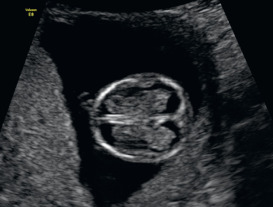
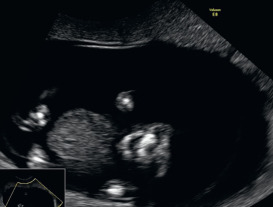
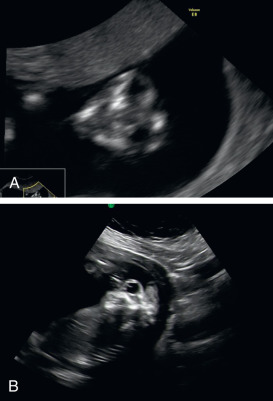
In exencephaly, the area cerebrovasculosa (i.e, the abnormal disorganized central nervous tissue that replaces the cerebral hemispheres) is prominent as outwardly extruding brain tissue ( Figs. 41.4A,B ). The absence of the cranial bone and the abnormal shape of the exposed brain help distinguish between a normal immature brain and exencephaly.
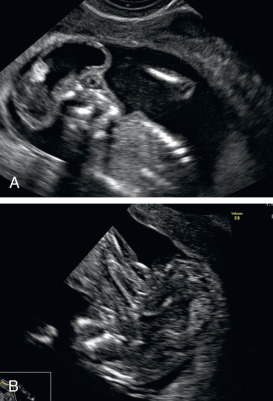
Etiology
In the majority of NTDs, the exact etiology is not known. Most NTDs occur sporadically, indicating heterogeneity, and in most affected pregnancies there are no recognizable risk factors.
Genetic and nongenetic factors such as parental socioeconomic status; exposure to teratogens, such as valproic acid, folic acid antagonists, vitamin A, and alcohol; and maternal diabetes, maternal obesity, and hyperthermia during early pregnancy have been discussed as risk factors.
Epidemiologic studies in the early 1990s showed a correlation between maternal folate status and neural tube defects. Subsequent studies confirmed that the recurrence risk for NTDs could be reduced by periconceptional supplementation with folic acid. Administration of folic acid before and during the first weeks of gestation can reduce the incidence of NTDs by 30% to 50%, but cannot completely prevent it; other factors must be involved. The etiology of NTDs is thought to be multifactorial, that is, with significant genetic components in combination with environmental risk factors.
The aneuploidy rate in fetuses with NTDs has been reported to be between 2% and 25%, including trisomy 18, partial trisomy of the long arm of chromosome 2, structural anomalies of chromosome 11, 13, and duplication of chromosome 11,13, tetraploidy, and triploidy. The rate of aneuploidy depends on the type of NTD: It is lower for anencephaly and meningomyelocele, with about 0.6% to 5%, and higher for encephaloceles with about 6% to 9%. Aneuploidy risks in NTDs are even higher if there are additional structural anomalies.
Anencephaly
Definition
Anencephaly is the absence of the cranial vault above the bony orbits, associated with the absence of the cerebral hemispheres and midbrain.
Prevalence and Epidemiology
The incidence of anencephaly in Europe is about 0.3 : 1000, but shows a wide regional variation. For example, in the United States, Denmark, South Africa, Taiwan, and India the average incidence is 1 : 1000 pregnancies, 3 : 1000 to 7 : 1000 in Ireland and Wales, but only 0.1 : 1000 to 0.6 : 1000 in France, Japan, Hungary, and former Yugoslavia. Similarly to spina bifida, the incidence is particularly high in the United Kingdom and low in Asia. The female-to-male ratio is about 4 : 1.
Etiology and Pathophysiology
Closure of the cranial neuropore normally occurs between 23 and 28 days. A failure in this process eventually leads to anencephaly, with incomplete development of the brain and lack of formation of the cranial bones above the orbits. Some consider anencephaly as an extreme form or end-stage of acrania, with the cerebral hemispheres having been destroyed by direct exposure to the amniotic cavity and constant trauma from fetal movements, bringing the brain tissue into contact with the uterine walls.
Clinical Presentation
Anencephaly is characterized by the absence of the cerebral hemispheres and the cranial vault. A layer of angiomatous stroma, but no skin, covers the defect. Brain development is incomplete: the brainstem and part of the midbrain are present. A part of the cerebral hemispheres may sometimes be observed in the first trimester; this condition is usually called exencephaly. Anencephaly may be associated with spina bifida, urinary tract abnormalities, cleft lip and palate, gastrointestinal, and cardiac abnormalities.
The majority of neonates with anencephaly die within hours or a few days of birth. The mortality in utero is 23%, and approximately 35% during labor; neonatal survival up to 8 days has been reported. An observational study of the natural history of anencephaly showed that about 25% of ongoing pregnancies are complicated by polyhydramnios, and nearly 20% of deliveries are complicated by shoulder dystocia. Furthermore, this study reported an increased rate of other complications including prolonged induction and delay in the second stage of labor.
Imaging Technique and Findings
Anencephaly was the first fetal anomaly diagnosed by antenatal US in 1972. Nowadays, exencephaly is often diagnosed in the first trimester, by demonstrating the irregularity of the cephalic pole with protrusion of the brain mass and irregular shape of the cranial pole, resulting in a characteristic image in the coronal plane that has been called the “Mickey Mouse sign” ( Figs. 41.5 and 41.6 ).
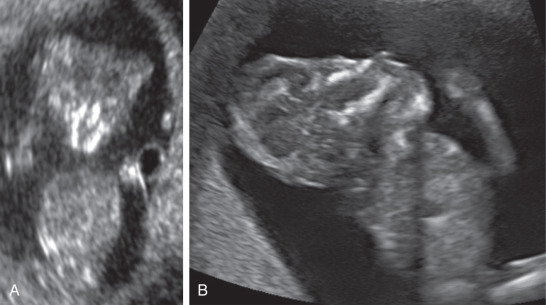
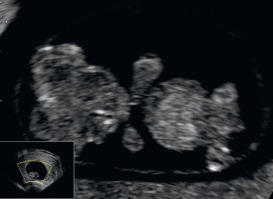
In the second trimester, the absence of the calvarium is easily recognized above the orbits, which look prominent ( Figs. 41.7A,B ). There is little or no brain remaining above the base of the skull.
“Mickey Mouse” face in the first trimester. Absence of the calvarium above the bony orbits in the second trimester.

Differential Diagnosis From Imaging Findings
Extreme microcrania or large encephaloceles can be confused with anencephaly, but in microcrania the calvarium is present and not interrupted. Amniotic band syndrome may cause destruction of the cranial vault, but usually this is accompanied by other abnormalities, such as limb amputation. Acrania, exencephaly, and anencephaly may be part of the same spectrum of abnormalities.
Other Imaging Modalities
Magnetic resonance imaging (MRI) can be a sensitive tool for certain aspects of brain anomalies, mainly maturation of the brain, but in fetal anencephaly or exencephaly, MRI usually does not provide additional information. Fetal MRI as an adjunct to US may help identify topography, to add CNS and non-CNS findings, and may be helpful in the evaluation of complex forms of encephaloceles. Its value is questionable with regard to changing the detailed sonographic diagnosis, or in particular the management in anencephaly of encephaloceles.
Other Applicable Modalities
Maternal serum alpha-fetoprotein (MSAFP) is increased in open NTDs, and has been used for NTD screening for more than 30 years. Using MSAFP cut-off levels of 2 or 2.5 multiples of the median for a given gestational age in singleton pregnancies, the detection rates are about 95%, and between 70% and 85% for anencephaly and open NTD, respectively. The proper cut-off to use can vary between labs, and practitioners should be familiar with the standards of their local labs. The cut-off will usually correspond to about the 95th centile for the normal population, so there will be a 5% screen positive rate (i.e., 5% of normal pregnancies will have a value above the cut-off).
Many centers use high-resolution US in conjunction with MSAFP screening, and detection rates depend on the gestational age, and the type and severity of the NTD. First-trimester studies showed high detection rates of >90% for anencephaly and encephalocele (80%), but much lower detection rates for open spina bifida ; at least before the introduction of a detailed anatomic assessment of the posterior fossa during the early anomaly scan.
Synopsis of Treatment Options
Termination of pregnancy should be offered.
In monochorionic twins, selective termination of the anencephalic fetus may be more harmful to the unaffected twin than expectant management due to complications, such as preterm labor and preterm ruptured membranes, although radiofrequency or microwave interruption of circulation to the affected fetus can be considered, especially in the setting of severe polyhydramnios.
Prenatal
There are no prenatal treatment options. Women who continue pregnancies with exencephaly or anencephaly must be informed about the higher risk of pregnancy complications including preeclampsia, polyhydramnios, and antepartum hemorrhage.
Postnatal
Anencephaly and exencephaly are uniformly lethal and cannot be treated.
Most NTDs occur sporadically and are multifactorial in origin. Anencephaly is a lethal condition characterized by the absence of the cranial vault above the bony orbits and absence of the cerebral hemispheres. Termination of pregnancy should be offered.
Generally, fetuses with anencephaly, exencephaly, and most of the fetuses with encephaloceles are detectable early, many even at the time of first screening for fetal anomalies between 11 and 14 weeks. Altered anatomy of the posterior fossa may indicate open spina bifida during an early anomaly scan.
Folic acid supplementation before, and around the time of conception may reduce the risk of occurrence and recurrence of NTDs by two-thirds. The standard dose is 0.4 mg daily, which can be increased to 4 mg daily in high-risk pregnancies (previous NTD).
- •
Anencephaly is a NTD characterized by the absence of the cranial vault above the bony orbits and absent cerebral hemispheres.
- •
Diagnosis can be difficult in the first trimester but is usually easy in the second trimester.
- •
Anencephaly is always fatal, and termination of pregnancy should be offered.
- •
Folic acid supplementation around the time of conception can be useful for reducing the risk of an affected fetus.
Encephalocele
Definition
Encephalocele is the protrusion of intracranial structures through a defect in the skull. The herniated sac may contain meninges and brain tissue (encephalocele) or only meninges (meningocele).
Synonyms: cephalocele, cranial or occipital meningocele, cranium bifidum, encephalomeningocele, encephalomeningocystocele.
Prevalence and Epidemiology
Encephaloceles account for 10% to 20% of all craniospinal dysraphisms. The prevalence of encephalocele is approximately 0.8 : 10,000 to 4 : 10,000 live births, and is higher in Southeast Asia (2 : 10,000). Overall, posterior encephaloceles are more common than anterior defects but substantial ethnic differences exist: occipital cephalocele is more common in the Western hemisphere, whereas frontal cephalocele is more frequent in Asia, especially Thailand.
Etiology and Pathophysiology
Occipital encephaloceles are usually considered part of the spectrum of NTDs, which are thought to have a multifactorial origin. An environmental cause has been postulated for frontal encephaloceles. The two main etiologic theories include a failure of anterior fusion of the neural folds (with resulting failure of skull development) or the herniation of the brain through a bony malformation. The insult is thought to occur around day 50 of gestation.
Encephaloceles may be isolated, but are often (23% to 37.5%) associated with other structural anomalies, including other CNS and extra-CNS abnormalities, and genetic syndromes, most commonly Meckel-Gruber syndrome ( Chapter 133 ), an autosomal recessive disorder with a 25% recurrence risk. Another typical anomaly that occurs associated with encephalocele is the consequence of an embryonic rupture of the amniotic membrane, the so-called amnion rupture sequence ( Chapter 98 ).
The recurrence risk of isolated encephalocele is 2% to 5%, but 10% if there are two affected siblings.
Clinical Presentation
Encephaloceles may be classified as occipital (between the lambdoid suture and foramen magnum), parietal (between the bregma and the lambdoid suture), or anterior (between the bregma and the ethmoid bone). Anterior encephaloceles are further divided in frontal (external lesions near the root of the nose) and basal (internal lesions within the nose, the pharynx or the orbit). Three out of four encephaloceles are occipital. Parietal and frontal encephaloceles are more common in some regions in Asia.
The prognosis of fetuses with encephalocele is poor. The survival rate is decreased and the prevalence of mental retardation is significant. The prognosis of an encephalocele depends on the size of the defect, the presence of herniated brain tissue, and on associated anomalies or syndromes. An isolated encephalocele has a better prognosis.
Imaging Technique and Findings
Antenatal diagnosis of encephalocele is usually easy. On US, it appears as a paracranial mass with brain tissue inside the herniated sac ( Figs. 41.8–41.10 ). The skin is usually intact above the defect. Internal encephaloceles may not be diagnosable by prenatal ultrasound.
Skull defect with herniation of a sac filled with brain tissue.
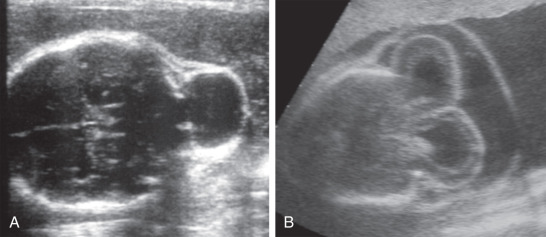

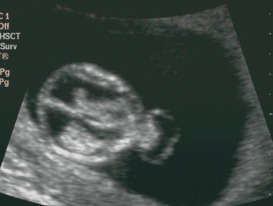
Differential Diagnosis From Imaging Findings
Occipital meningocele must be differentiated from cystic hygroma. The demonstration of the skull defect can be difficult, as the bony discontinuity is usually small. Encephaloceles have a small base and are usually accompanied by other intracranial findings (ventriculomegaly, obliterated cisterna magna, frontal bossing), whereas cystic hygroma originates from the neck and has a large base.
Frontal encephalocele must be differentiated from a dermoid cyst of the anterior fontanel and dacryocystocele.
Treatment Options
Determining factors are the size, the amount of herniated neural tissue, and the presence of hydrocephalus or other anomalies. Occipital encephaloceles are associated with higher rates of hydrocephalus and seizures, whereas anterior encephaloceles carry a better prognosis. However, surgery of anterior encephalocele is more challenging.
Synopsis of Treatment Options
- •
Anatomic survey for associated anomalies
- •
Karyotyping
- •
Offer of termination of pregnancy if appropriate
- •
Mode and time of delivery depending on the size of the defect
Stay updated, free articles. Join our Telegram channel

Full access? Get Clinical Tree







